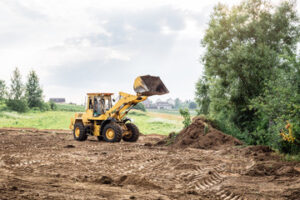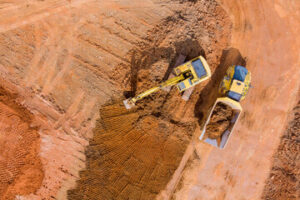Land Clearing Bryan TX involves the systematic removal of trees, brush, and other vegetation from a site. It prepares the ground for construction, farming, or other uses. It also reduces fire risks and improves property values.

Poor clearing techniques can destroy soil fertility, reducing the amount of arable land. They can also cause erosion and build-up of sediment in waterways.
The cost of clearing land can vary significantly depending on the size and complexity of the project. The amount of vegetation to be cleared, the type and density of the foliage, and any other additional work like tree removal or stump grinding will affect costs. Additionally, if the land needs to be graded or if hazardous materials like asbestos or buried fuel tanks need to be removed from the property, these extra expenses can add up quickly.
Another factor that influences land clearing costs is the location of the site. Remote or challenging-to-reach sites will incur higher rental and transportation costs for equipment. And finally, the choice of clearing method will also impact expenses. Mechanical clearing uses heavier machinery like bulldozers or excavators and requires a higher level of expertise than manual clearing techniques.
Land clearing can be necessary for a variety of reasons, from developing construction or agriculture projects to maintaining the health and beauty of a property. However, it is important to consider the environmental impact of any clearing project before starting. Deforestation can contribute to soil erosion, damage local ecosystems, and even affect climate change by releasing carbon stored in vegetation into the atmosphere.
Clearing land has many benefits beyond simply preparing it for development or planting, such as reducing the risk of fire, creating habitats for wildlife, and improving water flow through a property. Regardless of the purpose, proper planning and execution are essential for minimizing costs and ensuring that the project is completed on time and within budget.
It is also important to note that land clearing can require various permits and inspections, which may increase the overall project cost. Incorporating permit costs into the overall budget will help to avoid any unexpected expenses and ensure that all required regulations are followed. It is a good idea to consult with local authorities and contractors to ensure that all requirements are met before commencing any clearing project.
Environment
Land Clearing is a controversial practice that can have adverse effects on the environment. It disrupts natural water cycles and reduces available habitat for wildlife. It also leads to soil erosion and increased greenhouse gas emissions. However, there are ways to balance economic development goals with environmental conservation. Sustainable clearing techniques can help preserve ecosystems while allowing for needed growth in agriculture and infrastructure.
Land clearing is necessary for agricultural expansion, livestock grazing, and construction projects. It can be done with manual labor or with specialized equipment. Land clearing can also be used to create recreational facilities such as parks and golf courses. Cleared land can also be used for energy production, including solar and wind farms.
One of the most important benefits of land clearing is its ability to increase property value. Land that is cleared has a more open, attractive appearance, which makes it more appealing to potential buyers or tenants. Additionally, clearing the land can allow for easier access to buildings and other structures. In addition, it can provide space for outdoor activities and improve the overall safety of a property.
Many land clearing activities require a permit or clearance from local authorities. This process involves submitting detailed information about the project and consulting with environmental agencies. The permit or clearance is important to ensure that the land clearing is carried out in a responsible manner and will not cause any environmental problems. It can also be a good way to keep track of the progress of the land clearing.
When a land clearing project is completed, it is important to use proper soil management practices to avoid erosion. Without adequate ground cover, the soil can be easily washed away by rain and wind. This can reduce the fertility of the soil and damage nearby structures. Moreover, it can also pollute waterways and lead to algal blooms and marine habitat degradation.
Land clearing can also help to prevent wildfires by creating defensible space around homes and businesses. This is especially important in areas prone to fire hazards. It can also reduce the spread of wildfires, which can destroy crops and other vegetation.
Safety
The process of clearing land can be dangerous, especially if the project is not done correctly. It is important to hire a professional who has the skills and expertise to complete the job safely and efficiently. They can also assist in navigating environmental regulations and ensuring that the work site is safe. A dedicated safety officer or supervisor should be present at all times to oversee and enforce safety protocols. This ensures that everyone is aware of the proper procedures and will be able to respond quickly in case of an emergency.
It is also essential to use the right equipment for the job. This can include anything from basic hand tools, such as axses or shovels, to power equipment, such as bulldozers or excavators. Using the appropriate gear helps protect workers from injuries, such as cuts or punctures. In addition, it is important to wear protective clothing, such as long pants and closed-toe shoes. It is also a good idea to wear a hard hat and goggles to protect against falling debris or objects. Power equipment and machinery can also produce loud noises that may damage the ears, so it is important to use earplugs or earmuffs.
Another potential hazard is the risk of fires during the clearing process. This can be caused by the burning of brush or tree stumps, or from sparks from heavy machinery. During the clearing process, it is also important to take precautions to avoid fires, such as by making sure that all equipment is well-maintained and kept away from overhead power lines.
Safety is a top priority in any Land Clearing project, and it is important to make sure that all workers are properly trained and wearing the proper protective gear. Regular inspections of all equipment is also crucial, as this can help identify any issues that may impact the quality of the work or the safety of workers.
Lastly, it is important to be familiar with any local environmental regulations and laws regarding Land Clearing before beginning the project. This can prevent legal complications down the road, and it can also help you avoid costly fines.
Efficiency
One of the most important aspects of land clearing is speed. Achieving the desired results in a timely manner requires the right equipment and thorough pre-planning. It is also crucial to consider the local environment and ensure compliance with environmental regulations. This can prevent costly delays and fines due to violations.
Inefficient land clearing techniques can have significant negative consequences on the surrounding ecosystems. For example, the removal of trees leaves bare soil susceptible to erosion and nutrient loss. This can negatively impact waterways and soil health, and even cause damage to wildlife habitats. In addition, traditional clearing methods often result in the use of herbicides, which can be harmful to non-target plants and animals.
Professional land clearing services can help minimize the environmental impact of your project. They can utilize mechanized equipment, such as bulldozers and excavators, to clear large areas quickly and efficiently. These machines are designed to handle tough tasks like uprooting trees and dense brush, reducing the time needed for clearing and saving resources. Additionally, professional clearing companies can employ forestry mulching to reduce erosion and protect the topsoil from nutrient loss.
Clearing the land makes it more accessible for construction, agriculture, and other uses. In addition, it can reveal the true potential of a property and improve its market value. Lastly, it can help reduce the risk of injury from overgrown vegetation and improve visibility in hazardous areas.
Although clearing the land is a necessary part of urban development, it can have a variety of unintended ecological impacts. The primary concern is that it can disrupt the natural balance of wildlife and erode the land’s ecological systems. This can lead to the degradation of natural landscapes and contribute to climate change.
To avoid these effects, it is important to conduct a biodiversity assessment before beginning any clearing project. This will identify any vulnerable species or habitats that need to be protected. It is also advisable to avoid clearing during breeding or migration periods. In addition, it is important to utilise existing vegetation and promote the growth of native grasses and shrubs to minimise disturbances to ecosystems.
